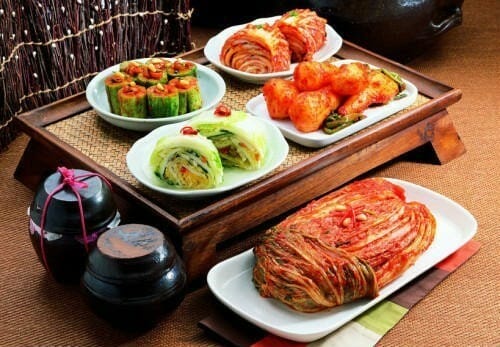- Health Is Wealth
- Posts
- Kimchi health benefits- Chinese food and natural health
Kimchi health benefits- Chinese food and natural health

Kimchi health benefits
Kimchi is a traditional Korean dish made of peppers and lacto-fermented vegetables, that is to say, soaked in brine for several weeks until the development of acidity. One of the best known in Europe is in Chinese cabbage base. Originally, the word meant vegetable kimchi (Chinese: 菜; pinyin: CAI) overwhelmed (Chinese: 沈; pinyin: SHEN). It is a staple food in Korea, often accompanying the dishes of this country such as banchan.
baechu gimchi, one of many kinds of kimchi
Kimchi in the midst of other banchan, small side dishes of traditional Korean meals
Jars used to prepare the kimchi
The most common ingredients of kimchi are Chinese cabbage, carrots, radishes such as white radish, garlic, red pepper, fresh white onion, fermented or other seafood shrimp, ginger, salt and sugar. While usually associated with Chinese cabbage kimchi fermented with a mixture of red pepper, garlic, ginger, salt and fish sauce (paech’u kimch’i), there are different types of kimchi, which several regional and seasonal varieties. We find for example kaktugi, based radish, and oisobagi, based stuffed cucumber. The kaennip consists of layers of perilla leaves marinated in soy sauce mixture, chiles, garlic, green onions and other spices.
The baechu kimchi (Chinese cabbage kimchi), which is the variety of kimchi the most widespread today, is actually relatively new. Red peppers were introduced to Korea by the Japanese in the early seventeenth century and their use in the kimchi did not become popular until two centuries later. Chinese cabbage has probably not been introduced in Korea before the nineteenth century; previously, kimchi was to be made from indigenous vegetables.
Kimchi can be prepared with the Western cabbage if it is not possible to purchase Chinese cabbage. In Korea, kimchi is a popular accompaniment, but is also often used as a food ingredient, eg in chigae kimchi (kimchi soup) or bokkumbap kimchi (kimchi fried rice).
Its fermentation is done in terracotta jars buried, some of the land and can last several months or even years.
Kimchi health benefits
Lactobacilli being deeply involved in the kimchi fermentation, it results in lactic acid concentration greater than that of yoghurt. In East Asia, the low number of cases of SARS (severe acute respiratory syndrome) in Korea is sometimes attributed to the Korean habit of consuming large quantities of kimchi, although no link between the consumption and resistance SARS has been scientifically established. In Korea, kimchi is considered beneficial for health, brassicaceaes are considered good for cancer prevention. However, while some studies have linked the consumption of kimchi with a reduced risk of colon cancer, others have associated with an increased risk of cancer if they come from products prepared industrially with many additives.
Economy
In 2010, poor weather in South Korea caused a drop in Chinese cabbage harvest 150 000 tonnes instead of 250 in 0002. Consequently, the price of cabbage has quadrupled, reaching 7.30 euros each, and by causing repercussion an increase in prices of all locaux2 fruits and vegetables. The government responded by suspending tariffs on Chinese cabbage, and announcing the import of 100 tons of cabbage and 50 tons of radishes from China2. This announcement caused the rise in cabbage prices in China, as well as other vegetables.
Ethnology
Kimchi is also the “cheese” traditional Koreans when they are captured.
Read more about Chinese food culture
Kimchi health benefits source:https://account.meilishuo.com